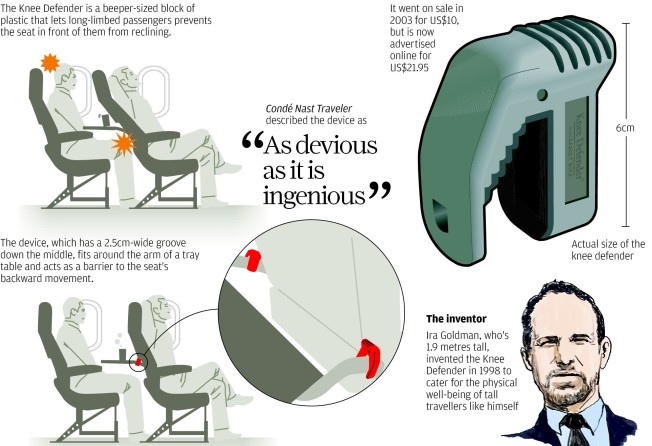signalmankenneth
Verified User
They should get rid of the reclining seats too!
(CNN) — The airplane seat recline button -- so controversial that it inspired an entire micro-industry of devices to stop the passenger in front leaning into your space.
At one point in time all economy class airline seats had built-in recline. Today, there are entire seat models that simply don't have the option.
So what happened to make reclining seats disappear in some places? And is that a good thing, or a bad thing? Just because a passenger can recline their seat, should they?
As with so much in the airline business, it depends on who you ask.
Let's talk about how recline works. At its most basic, there's a mechanism hidden in the structure underneath your seat cushion that contains a pivot, the wires connecting it to the button on your armrest, and a pneumatic canister that returns the seat to an upright position. Seatmakers call this kinematics: the parts that move.
For airlines, this represents a cost, firstly from maintenance: any kind of mechanism is prone to breaking, whether from normal wear and tear or because passengers don't treat airplanes gently.
Secondly, it's a weight cost, because these mechanisms can quickly add up. Most modern and lightweight airplane seats are somewhere between seven and 10 kilograms (15-22 pounds) per passenger today. Any weight that can be saved means reducing the fuel needed to carry it.
And thirdly -- and in some ways most importantly -- it's a disruption cost, because if passengers are fighting with each other over seat reclining etiquette, then flight attendants have to play schoolyard monitor. In some cases, passengers got so disruptive that flights have even diverted for safety.
So, what if seats didn't recline?
In the late 2000s, a new generation of highly engineered super-lightweight seats started to break into the market, and part of what made them super-lightweight was that there was no recline function. Some marketing genius thought of calling them "pre-reclined," fixing the backrest at an angle somewhere between fully upright and slightly reclined.
Initially, they were mostly aimed at low-cost carriers. Usually operating flights of just a few hours, these airlines are famous for cutting all the frills out of their operation.
An early adopter was UK airline Jet2, a European package vacation company, which in 2009 chose a pre-reclined seat from then-upstart seatmaker Acro that revolutionized how airlines think about seats.
Then called Clark, and now called Series 3, Acro's seat was different in several key ways.
The lack of recline was one of them, but another was the innovative way that the seat was sculpted out of the seat pan and backrest into a fixed, concave "bucket" shape.
https://www.cnn.com/travel/article/reclining-seats-airplanes/index.html


(CNN) — The airplane seat recline button -- so controversial that it inspired an entire micro-industry of devices to stop the passenger in front leaning into your space.
At one point in time all economy class airline seats had built-in recline. Today, there are entire seat models that simply don't have the option.
So what happened to make reclining seats disappear in some places? And is that a good thing, or a bad thing? Just because a passenger can recline their seat, should they?
As with so much in the airline business, it depends on who you ask.
Let's talk about how recline works. At its most basic, there's a mechanism hidden in the structure underneath your seat cushion that contains a pivot, the wires connecting it to the button on your armrest, and a pneumatic canister that returns the seat to an upright position. Seatmakers call this kinematics: the parts that move.
For airlines, this represents a cost, firstly from maintenance: any kind of mechanism is prone to breaking, whether from normal wear and tear or because passengers don't treat airplanes gently.
Secondly, it's a weight cost, because these mechanisms can quickly add up. Most modern and lightweight airplane seats are somewhere between seven and 10 kilograms (15-22 pounds) per passenger today. Any weight that can be saved means reducing the fuel needed to carry it.
And thirdly -- and in some ways most importantly -- it's a disruption cost, because if passengers are fighting with each other over seat reclining etiquette, then flight attendants have to play schoolyard monitor. In some cases, passengers got so disruptive that flights have even diverted for safety.
So, what if seats didn't recline?
In the late 2000s, a new generation of highly engineered super-lightweight seats started to break into the market, and part of what made them super-lightweight was that there was no recline function. Some marketing genius thought of calling them "pre-reclined," fixing the backrest at an angle somewhere between fully upright and slightly reclined.
Initially, they were mostly aimed at low-cost carriers. Usually operating flights of just a few hours, these airlines are famous for cutting all the frills out of their operation.
An early adopter was UK airline Jet2, a European package vacation company, which in 2009 chose a pre-reclined seat from then-upstart seatmaker Acro that revolutionized how airlines think about seats.
Then called Clark, and now called Series 3, Acro's seat was different in several key ways.
The lack of recline was one of them, but another was the innovative way that the seat was sculpted out of the seat pan and backrest into a fixed, concave "bucket" shape.
https://www.cnn.com/travel/article/reclining-seats-airplanes/index.html



